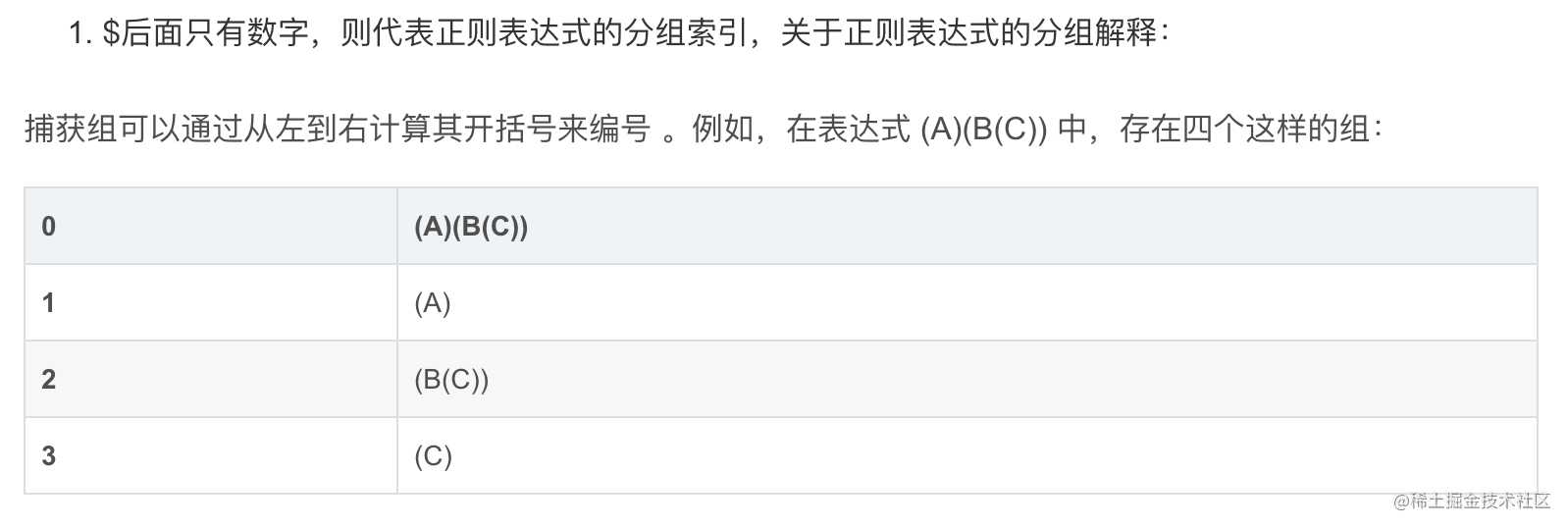准则
- 默认是最短匹配,只要字符串满足条件就返回。
- 如果没有匹配到,都是返回为
nil。 - 如果需要做最长匹配,调用
Longest()函数。 - 正则表达式功能:匹配(macth),查找(find)和替换(replace)。
- 存在长度选择的函数,传入
<0的数字表示匹配全部。
使用regexp调用
Match,MatchReader和 MatchString
// 判断b中是够包含pattern能够组成的任意字符串
func Match(pattern string, b []byte) (matched bool, err error)
// 判断reader r中返回的字符串是否包含pattern能够组成的任意字符串
func MatchReader(pattern string, r io.RuneReader) (matched bool, err error)
// 判断字符串s中是否包含pattern能够组成的任意字符串
func MatchString(pattern string, s string) (matched bool, err error)
Compile 和 MushCompile
- func Compile(expr string) (*Regexp, error)
- func MustCompile(str string) *Regexp
Compile:返回Regexp对象,方便调用指针函数。
MustCompile:同Compile,解析表达式失败,会panic。
在匹配文本时,该正则表达式会尽可能早的开始匹配,并且在匹配过程中选择回溯搜索到的第一个匹配结果。这种模式被称为leftmost-first,另外一般情况下使用MustCompile即可。
使用regexp.Regexp对象来调用
Find 和 FindAll
- func (re *Regexp) Find(b []byte) []byte
- func (re *Regexp) FindAll(b []byte, n int) [][]byte
Find返回保管正则表达式re在b中的最左侧的一个匹配结果的[]byte切片。如果没有匹配到,会返回nil,最多匹配一个。
re := regexp.MustCompile(`foo.?`)
fmt.Printf("%q\n", re.Find([]byte(`seafood fool`)))
re := regexp.MustCompile(`foo.?`)
fmt.Printf("%q\n", re.FindAll([]byte(`seafood fool`), -1))
FindAll功能与Find一样,只是返回全部满足条件的数据。
FindString 和 FindAllString
- func (re *Regexp) FindString(s string) string
- func (re *Regexp) FindAllString(s string, n int) []string
与Find和FindAll一样,只是针对字符串string操作。
FindIndex 和 FindAllIndex
-
func (re *Regexp) FindIndex(b []byte) (loc []int)
-
func (re *Regexp) FindAllIndex(b []byte, n int) [][]int
FindIndex, 返回b中满足匹配字符串部分的起始位置,同样是**“leftmost-first”**原则,loc包含起止位置。如果没有找到,直接返回nil。
FindAllIndex,功能和FindIndex保持一致,只是匹配多个,n决定了匹配的位置。
FindStringIndex 和 FindAllStringIndex
- func (re *Regexp) FindStringIndex(s string) (loc []int)
- func (re *Regexp) FindAllStringIndex(s string, n int) [][]int
与FindIndex和FindAllIndex使用方式类似,只是针对的是字符串string。
FindStringSubmatch 和 FindAllStringSubmatch
- func (re *Regexp) FindStringSubmatch(s string) []string
FindStringSubmatch:采用左匹配原则,最多匹配一个,如果没有的话,返回nil。对于返回的[]string,分别标示匹配的字符串,子串。
re := regexp.MustCompile(`a(x*)b(y|z)c`)
fmt.Printf("%q\n", re.FindStringSubmatch("-axxxbyc-"))
fmt.Printf("%q\n", re.FindStringSubmatch("-abzc-"))
输出结果:
["axxxbyc" "xxx" "y"]
["abzc" "" "z"]
- func (re *Regexp) FindAllStringSubmatch(s string, n int) [][]string
和FindStringSubmatch使用类似,只是能顾选择匹配的长度,-1表示匹配到末尾。
re := regexp.MustCompile(`a(x*)b`)
fmt.Printf("%q\n", re.FindAllStringSubmatch("-ab-", -1))
fmt.Printf("%q\n", re.FindAllStringSubmatch("-axxb-", -1))
fmt.Printf("%q\n", re.FindAllStringSubmatch("-ab-axb-", -1))
fmt.Printf("%q\n", re.FindAllStringSubmatch("-axxb-ab-", -1))
输出结果:
[["ab" ""]]
[["axxb" "xx"]]
[["ab" ""] ["axb" "x"]]
[["axxb" "xx"] ["ab" ""]]
FindSubmatchIndex 和 FindAllSubmatchIndex
- func (re *Regexp) FindSubmatchIndex(b []byte) []int
- func (re *Regexp) FindAllSubmatchIndex(b []byte, n int) [][]int 计算子串在源串中的位置,已经存在
(x*)等返回结果处理,如果没有返回nil。
另外,index返回为左闭右开的模式,示例中的2,2表示空字符串的意思。 并且,不会存在重合匹配的,比如说”-axxb-ab-“去匹配a(x*)b,不会存在第一个a和最后一个b结合的情况,如果使用Longest就会匹配最长的。
re := regexp.MustCompile(`a(x*)b`)
// Indices:
// 01234567 012345678
// -ab-axb- -axxb-ab-
fmt.Println(re.FindAllStringSubmatchIndex("-ab-", -1))
fmt.Println(re.FindAllStringSubmatchIndex("-axxb-", -1))
fmt.Println(re.FindAllStringSubmatchIndex("-ab-axb-", -1))
fmt.Println(re.FindAllStringSubmatchIndex("-axxb-ab-", -1))
fmt.Println(re.FindAllStringSubmatchIndex("-foo-", -1))
输出结果:
[[1 3 2 2]] // 2 2 表示为空
[[1 5 2 4]]
[[1 3 2 2] [4 7 5 6]]
[[1 5 2 4] [6 8 7 7]]
[]
FindStringSubmatchIndex 和 FindAllStringSubmatchIndex
- func (re *Regexp) FindStringSubmatchIndex(s string) []int
- func (re *Regexp) FindAllStringSubmatchIndex(s string, n int) [][]int
和FindSubmatchIndex,FindAllSubmatchIndex保持一致。
Longest
- func (re *Regexp) Longest() 获取最长匹配的满足条件的内容。
re := regexp.MustCompile(`a(|b)`)
fmt.Println(re.FindString("ab"))
re.Longest()
fmt.Println(re.FindString("ab"))
输出结果:
a
ab
下面这种情况不会最长匹配。
re := regexp.MustCompile(`a(x*)b`)
re.Longest()
fmt.Println(re.FindString("-axxb-ab-")) // axxb,不会存在第一个a和最后一个b组合的过程。
Match,MatchString和MatchReader
- func (re *Regexp) Match(b []byte) bool
- func (re *Regexp) MatchString(s string) bool
- func (re *Regexp) MatchReader(r io.RuneReader) bool
判断b,s和r返回的数据是否满足正则表达式,返回true或者false。
NumSubexp
- func (re *Regexp) NumSubexp() int
返回分组的数量。
re0 := regexp.MustCompile(`a.`)
fmt.Printf("%d\n", re0.NumSubexp())
re := regexp.MustCompile(`(.*)((a)b)(.*)a`)
fmt.Println(re.NumSubexp())
输出结果:
0
4
ReplaceAll 和 ReplaceAllString
- func (re *Regexp) ReplaceAll(src, repl []byte) []byte
- func (re *Regexp) ReplaceAllString(src, repl string) string
ReplaceAllString与ReplaceAll使用方式相同。
re := regexp.MustCompile(`a(x*)b`)
fmt.Printf("%s\n", re.ReplaceAll([]byte("-ab-axxb-"), []byte("T")))
fmt.Printf("%s\n", re.ReplaceAll([]byte("-ab-axxb-"), []byte("$1"))) // $1表示匹配的第一个子串,这是ab的中间无字符串,所以$1为空,然后使用空去替换满足正则表达式的部分。
fmt.Printf("%s\n", re.ReplaceAll([]byte("-ab-axxb-"), []byte("$1W"))) // "$1W"等价与"$(1W)",值为空,将满足条件的部分完全替换为空。
fmt.Printf("%s\n", re.ReplaceAll([]byte("-ab-axxb-"), []byte("${1}W"))) // ${1}匹配(x*),保留。输出-W-xxW-
输出结果:
-T-T-
--xx-
---
-W-xxW-
s := "Hello World, 123 Go!"
//定义一个正则表达式reg,匹配Hello或者Go
reg := regexp.MustCompile(`(Hell|G)o`)
s2 := "2019-12-01,test"
//定义一个正则表达式reg2,匹配 YYYY-MM-DD 的日期格式
reg2 := regexp.MustCompile(`(\d{4})-(\d{2})-(\d{2})`)
//最简单的情况,用“T替换”"-ab-axxb-"中符合正则"a(x*)b"的部分
reg3 := regexp.MustCompile("a(x*)b")
fmt.Println(re.ReplaceAllString("-ab-axxb-", "T")) // -T-T-
//${1}匹配"Hello World, 123 Go!"中符合正则`(Hell|G)`的部分并保留,去掉"Hello"与"Go"中的'o'并用"ddd"追加
rep1 := "${1}ddd"
fmt.Printf("%q\n", reg.ReplaceAllString(s, rep1)) // Hellddd World, 123 Gddd!
//首先,"2019-12-01,test"中符合正则表达式`(\d{4})-(\d{2})-(\d{2})`的部分是"2019-12-01",将该部分匹配'(\d{4})'的'2019'保留,去掉剩余部分
rep2 := "${1}"
fmt.Printf("%q\n", reg2.ReplaceAllString(s2,rep2)) // 2019,test
//首先,"2019-12-01,test"中符合正则表达式`(\d{4})-(\d{2})-(\d{2})`的部分是"2019-12-01",将该部分匹配'(\d{2})'的'12'保留,去掉剩余部分
rep3 := "${2}"
fmt.Printf("%q\n", reg2.ReplaceAllString(s2,rep3)) // 12,test
//首先,"2019-12-01,test"中符合正则表达式`(\d{4})-(\d{2})-(\d{2})`的部分是"2019-12-01",将该部分匹配'(\d{2})'的'01'保留,去掉剩余部分,并追加"13:30:12"
rep4 := "${3}:13:30:12"
fmt.Printf("%q\n", reg2.ReplaceAllString(s2,rep4)) // 01:13:30:12,test
}
ReplaceAllFunc 和 ReplaceAllStringFunc
- func (re *Regexp) ReplaceAllFunc(src []byte, repl func([]byte) []byte) []byte
- func (re *Regexp) ReplaceAllStringFunc(src string, repl func(string) string) string
将匹配出来满足条件的[]byte作为参数传入函数中。
re := regexp.MustCompile(`[^aeiou]`)
fmt.Println(re.ReplaceAllStringFunc("seafood fool", strings.ToUpper))
两者使用方式类似。
ReplaceAllLiteral 和 ReplaceAllLiteralString
- func (re *Regexp) ReplaceAllLiteral(src, repl []byte) []byte
- func (re *Regexp) ReplaceAllLiteralString(src, repl string) string
匹配字面常量,不转换。
re := regexp.MustCompile(`a(x*)b`)
fmt.Println(re.ReplaceAllLiteralString("-ab-axxb-", "T"))
fmt.Println(re.ReplaceAllLiteralString("-ab-axxb-", "$1"))
fmt.Println(re.ReplaceAllLiteralString("-ab-axxb-", "${1}"))
输出结果:
-T-T-
-$1-$1-
-${1}-${1}-
关于$1说明:


Expand 和 ExpandString
- func (re *Regexp) Expand(dst []byte, template []byte, src []byte, match []int) []byte
- func (re *Regexp) ExpandString(dst []byte, template string, src string, match []int) []byte
Expand返回新生成的将template添加到dst后面的切片。在添加时,Expand会将template中的变量替换为从src匹配的结果。match应该是被FindSubmatchIndex返回的匹配结果起止位置索引。(通常就是匹配src,除非你要将匹配得到的位置用于另一个[]byte)
在template参数里,一个变量表示为格式如:
$name或${name}的字符串,其中name是长度>0的字母、数字和下划线的序列。一个单纯的数字字符名如$1会作为捕获分组的数字索引;其他的名字对应(?P…)语法产生的命名捕获分组的名字。超出范围的数字索引、索引对应的分组未匹配到文本、正则表达式中未出现的分组名,都会被替换为空切片。
$name格式的变量名,name会尽可能取最长序列:
$1x等价于${1x}而非${1}x,$10等价于${10}而非${1}0。因此$name适用在后跟空格/换行等字符的情况,${name}适用所有情况。
如果要在输出中插入一个字面值
'$',在template里可以使用?。
其他示例
解析网址
flysnowRegexp := regexp.MustCompile(`^http://www.flysnow.org/([\d]{4})/([\d]{2})/([\d]{2})/([\w-]+).html$`)
params := flysnowRegexp.FindStringSubmatch("http://www.flysnow.org/2018/01/20/golang-goquery-examples-selector.html")
// 返回[]string{}数据类型
for _, param := range params {
fmt.Println(param)
}
输出结果:
http://www.flysnow.org/2018/01/20/golang-goquery-examples-selector.html
2018
01
20
golang-goquery-examples-selector
今天的文章Go正则表达式使用分享到此就结束了,感谢您的阅读。
版权声明:本文内容由互联网用户自发贡献,该文观点仅代表作者本人。本站仅提供信息存储空间服务,不拥有所有权,不承担相关法律责任。如发现本站有涉嫌侵权/违法违规的内容, 请发送邮件至 举报,一经查实,本站将立刻删除。
如需转载请保留出处:http://bianchenghao.cn/15529.html
